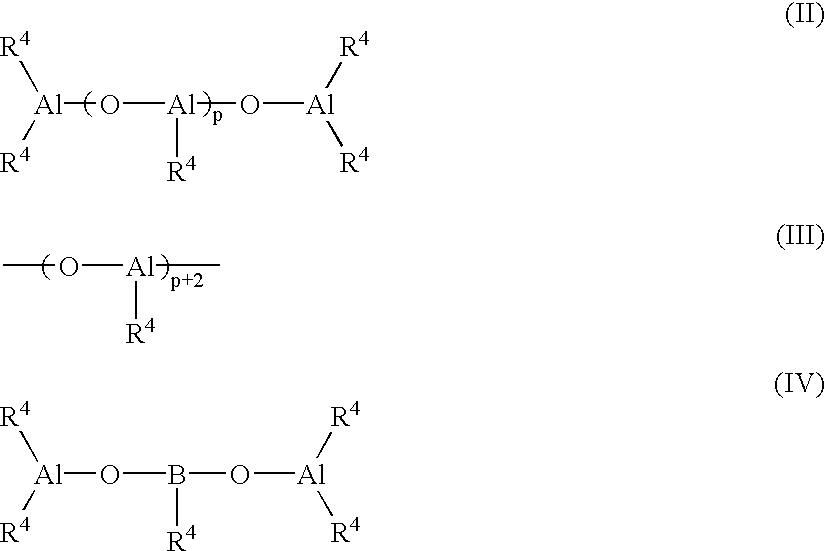Modified propylene polymer, composition containing the same and use thereof
a propylene polymer and polymer technology, applied in the direction of adhesive types, graft polymer adhesives, layered products, etc., can solve the problems of difficult coating and adhesion, special apparatus, and inability to say, and achieve excellent solubility, no stickiness, and good adhesion.
- Summary
- Abstract
- Description
- Claims
- Application Information
AI Technical Summary
Benefits of technology
Problems solved by technology
Method used
Image
Examples
reference example 1
[0158]
Mixture compositionPolypropylene block copolymer (trade name:60 parts by weightBC06C, mfd. by Japan Polychem, MFR = 60)Ethylene-propylene random copolymer (trade name:30 parts by weightEPO7P, mfd. by JSR)Talc (trade name: MT7, mfd. by Fuji Talc)10 parts by weight
[0159]As an antioxidant, 0.1 part by weight of tetrakis[methylene-3-(3′,5′-di-t-butyl-4′-hydroxyphenyl)propionate]methane (mfd. by Ciba Specialty Chemicals, IRGANOX 1010) was added to this mixture and mixed for 5 minutes using Henschel mixer, and then the resulting mixture was subjected to kneading granulation using a twin screw kneading machine (KCM 50, mfd. by Kobe Steel) at a setting temperature of 210° C. to obtain a thermoplastic resin composition. Thereafter, using an injection molding machine manufactured by Toshiba Machine (Toshiba IS170) and at a molding temperature of 220° C., this composition was formed into a test piece having a shape of 150 mm×70 mm×3 mm.
reference example 2
[0160]Using an injection molding machine manufactured by Toshiba Machine (Toshiba IS170) and at a molding temperature of 220° C., a polypropylene MA3U manufactured by Japan Polychem (propylene homopolymer, MFR: 15 g / 10 min (230° C., 21.18 N loading)) was formed into a test piece having a shape of 150 mm×70 mm×3 mm.
production example 1
(1) Synthesis of dichloro [dimethylsilylene(cyclopentadienyl)(2,4-dimethyl-4H-1-azulenyl)]hafnium
(1)-1 Synthesis of Ligand
[0161]2-Methylazulene (4.01 g) was dissolved in tetrahydrofuran (56 ml) and cooled to 0° C. in an ice bath, and then 24.8 ml of methyllithium diethyl ether solution (1.14 mol / l) was added dropwise thereto at the same temperature. After completion of the addition, the ice bath was removed and the mixture was stirred for 2 hours. This solution was slowly added dropwise to dimethylsilyl dichloride (34.0 ml, 0.280 mol) tetrahydrofuran solution (140 ml) which was cooled at 0° C. in an ice bath. After completion of the addition, the ice bath was removed, the mixture was stirred for 3 hours, and then the solvent and unreacted dimethylsilyl dichloride were evaporated under a reduced pressure. The residue was mixed with tetrahydrofuran (80 ml) and cooled to 0° C., cyclopentadienyl sodium (2.1 mol / l, 26.9 ml, 56.5 mmol) was gradually added dropwise thereto, and after compl...
PUM
| Property | Measurement | Unit |
|---|---|---|
| chemical shift | aaaaa | aaaaa |
| temperature | aaaaa | aaaaa |
| flip angle | aaaaa | aaaaa |
Abstract
Description
Claims
Application Information
 Login to View More
Login to View More - R&D
- Intellectual Property
- Life Sciences
- Materials
- Tech Scout
- Unparalleled Data Quality
- Higher Quality Content
- 60% Fewer Hallucinations
Browse by: Latest US Patents, China's latest patents, Technical Efficacy Thesaurus, Application Domain, Technology Topic, Popular Technical Reports.
© 2025 PatSnap. All rights reserved.Legal|Privacy policy|Modern Slavery Act Transparency Statement|Sitemap|About US| Contact US: help@patsnap.com


